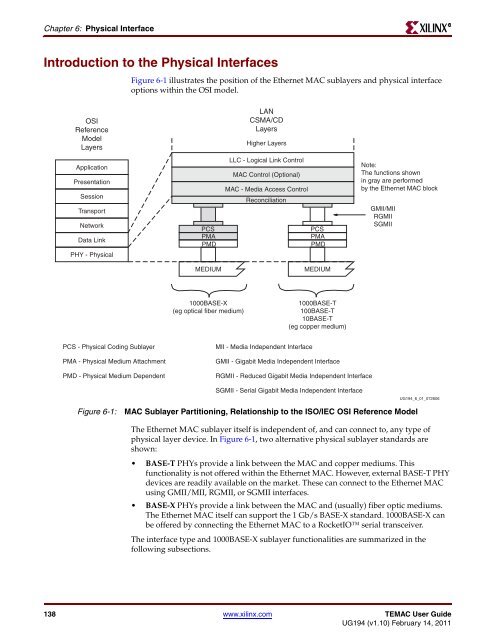Xilinx UG194 Virtex-5 FPGA Embedded Tri-Mode Ethernet MAC ...
Xilinx UG194 Virtex-5 FPGA Embedded Tri-Mode Ethernet MAC ...
Xilinx UG194 Virtex-5 FPGA Embedded Tri-Mode Ethernet MAC ...
Create successful ePaper yourself
Turn your PDF publications into a flip-book with our unique Google optimized e-Paper software.
Chapter 6: Physical Interface<br />
Introduction to the Physical Interfaces<br />
OSI<br />
Reference<br />
<strong>Mode</strong>l<br />
Layers<br />
Application<br />
Presentation<br />
Session<br />
Transport<br />
Network<br />
Data Link<br />
PHY - Physical<br />
PCS - Physical Coding Sublayer<br />
PMA - Physical Medium Attachment<br />
PMD - Physical Medium Dependent<br />
Figure 6-1 illustrates the position of the <strong>Ethernet</strong> <strong>MAC</strong> sublayers and physical interface<br />
options within the OSI model.<br />
PCS<br />
PMA<br />
PMD<br />
MEDIUM<br />
1000BASE-X<br />
(eg optical fiber medium)<br />
LAN<br />
CSMA/CD<br />
Layers<br />
Higher Layers<br />
LLC - Logical Link Control<br />
<strong>MAC</strong> Control (Optional)<br />
<strong>MAC</strong> - Media Access Control<br />
Reconciliation<br />
MII - Media Independent Interface<br />
Figure 6-1: <strong>MAC</strong> Sublayer Partitioning, Relationship to the ISO/IEC OSI Reference <strong>Mode</strong>l<br />
The <strong>Ethernet</strong> <strong>MAC</strong> sublayer itself is independent of, and can connect to, any type of<br />
physical layer device. In Figure 6-1, two alternative physical sublayer standards are<br />
shown:<br />
BASE-T PHYs provide a link between the <strong>MAC</strong> and copper mediums. This<br />
functionality is not offered within the <strong>Ethernet</strong> <strong>MAC</strong>. However, external BASE-T PHY<br />
devices are readily available on the market. These can connect to the <strong>Ethernet</strong> <strong>MAC</strong><br />
using GMII/MII, RGMII, or SGMII interfaces.<br />
BASE-X PHYs provide a link between the <strong>MAC</strong> and (usually) fiber optic mediums.<br />
The <strong>Ethernet</strong> <strong>MAC</strong> itself can support the 1 Gb/s BASE-X standard. 1000BASE-X can<br />
be offered by connecting the <strong>Ethernet</strong> <strong>MAC</strong> to a RocketIO serial transceiver.<br />
The interface type and 1000BASE-X sublayer functionalities are summarized in the<br />
following subsections.<br />
138 www.xilinx.com TE<strong>MAC</strong> User Guide<br />
<strong>UG194</strong> (v1.10) February 14, 2011<br />
PCS<br />
PMA<br />
PMD<br />
MEDIUM<br />
1000BASE-T<br />
100BASE-T<br />
10BASE-T<br />
(eg copper medium)<br />
GMII - Gigabit Media Independent Interface<br />
RGMII - Reduced Gigabit Media Independent Interface<br />
SGMII - Serial Gigabit Media Independent Interface<br />
Note:<br />
The functions shown<br />
in gray are performed<br />
by the <strong>Ethernet</strong> <strong>MAC</strong> block<br />
GMII/MII<br />
RGMII<br />
SGMII<br />
<strong>UG194</strong>_6_01_072606<br />
R

















